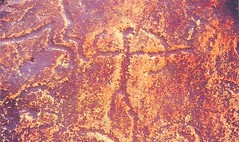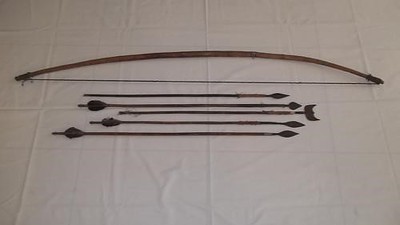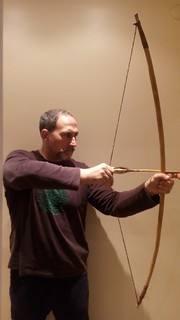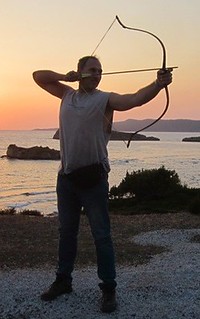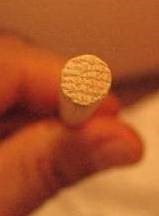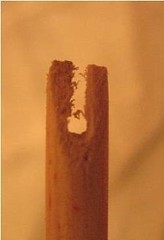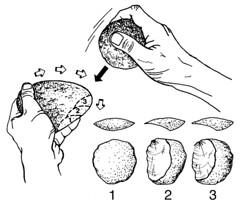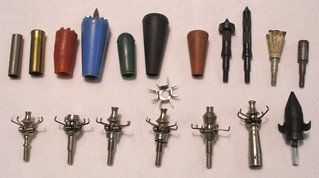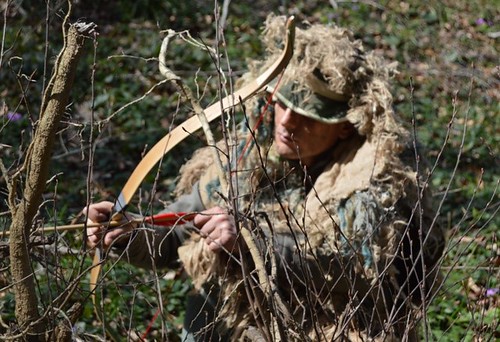 The Ultimate Survival Weapon-Part 3: Bow and Its PredecessorsDr. Murat Özveri “The history of bow and arrow is the history of humankind.” Fred Bear was a famous American outdoor man and bowhunter of the 20th century. The quotation is impressive; the impact of bow and arrow on humans’ development is undisputable. History starts with the invention of script, roughly 5,500 years ago however, bow and arrow have been around at least for 20,000 years, if not longer. Some older stone-heads are thought to have associated with other weapons. The history of humankind began much earlier than it learned writing, 300,000 years ago, as solid evidence like fossil findings suggest. There had been other weapons before bow and arrow ever existed. The romantic image of prehistoric hunters stalking deer and antelope with bow and arrow in their hands is historically credible since bow and arrow existed in late Paleolithic, maybe even earlier. Wall-paintings in south Europe and southeast Anatolia reveal solid proofs. Unluckily, the raw material that bow and arrow are made of are fragile and decompose fast. Well-preserved wooden artifacts that old are rare and the oldest are dated to 8,500-10,000 years. Thanks to Archaeology we know what humankind had had to hunt and self protect before a genius in the tribe invented a “wooden spring” that launched a “spear” downrange. These earlier weapons were less sophisticated but probably more suitable for killing larger animals. Spear should be the earliest thrusting weapon but had a limited range even if it was thrown per hand. Somewhere in the prehistory humans developed the throwing technology by using a lever of forearm-length to launch a long, flexible dart downrange. This weapon was still in use in Mezzo-America when Spanish invaders came to this continent. Aztecs called it “atlatl” and it is still the most common term in modern literature. In Australia it was used until very recently, until the early 20th century. It was named “woomera”. Another throwing technology is still a matter of debate. Short, femur-shaped clubs that had been excavated in big numbers have been thought of being a status symbol, a scepter staff held by the tribal leaders. Earlier naming, “Baton de Commandement” was based on this theory. Then it was claimed to be a spear-thrower. Some experimental studies showed that a spear can be thrown further together with a string wrapped around the shaft, than it would be per hand. This thrower didn’t seem to be as efficient as an atlatl but this theory could not be busted completely. An Australian woomera dated to the last years of the 19th century. These spear throwers were multi-purpose tools and used for digging, carrying food and even as musical instruments (above). An example from North America is thought to have belonged to Innu Indians who lived where today is Canada. It is from the late 19th century too (below). Atlatl gained popularity among enthusiasts of primitive technologies in the late 20th century. In the USA some states even permitted hunters to use this primitive weapon in hunting whitetail deer. This simple weapon was shown to be capable of killing large animals thank to the high momentum of its projectile. Despite its slower flight the higher mass makes it a formidable and dangerous weapon. Experimental archaeologists showed that killing bison with an atlatl is possible. They killed, skinned and chopped a bison by using the tools and techniques of our ancestors who had lived thousands of years ago and hunted bison on the same area. Recent experimental studies and on-field experience helped find new theories and supported existed ones. Prehistoric men hunted larger animals and needed a weapon that is more efficient in penetrating the enormous fat and muscle that protect the vital organs of gigantic animals like mammoths, hairy rhinoceros and mastodon. An atlatl dart is capable of doing that but throwing it requires a big body movement. Probably these animals were slower and not spooked by humans easily. Later smaller animals evolved. They were more sensitive, had more agility and the exaggerated hand and body movement of an atlatl throw spooked them. A faster projectile that can be thrown with less body movement and from a concealed position might have been needed. Bow could have been the new weapon that fulfilled these requirements. Faster arrows had less mass but provided enough momentum to kill smaller animals like deer and antelope. I told the story of predecessors of bow and arrow so far, but this way I think I gave an idea what an atlatl is and under which circumstances it can be used. Atlatl is a weapon that is easy to make and that way it fulfills one of the most important requirements of an ultimate survival weapon. A slight flexible and curved branch with a hook at the tip would make the thrower. It should be slightly longer than your forearm. A dart of 180 to 220 cm in length made of either a tree sapling or cane makes a great projectile. If you use cane or reed, a wooden foreshaft is necessary to make the projectile front-heavy a bit. Originals were tipped with small stone-heads but in survival conditions a fire-hardened wooden tip would do the job. Getting sharp flakes from a rock is not the most difficult task, but you do not need to worry too much if you don’t have any know-how or experience. The dart may be fletched with two to three natural bird feathers which can even be found in nature. But a front-heavy dart can be thrown straight even without fletching, with some practice though. In order to hunt with an atlatl successfully the game animals should be less sensitive to humans. If the survivor is really in a remote place where no human settlements exist animals would probably be not too shy due to the lack of hunting pressure. Even if the animals are spooked easily there may be solutions like shooting from a tree where the throwing movement can be hidden from the prey. On the other hand, too thick vegetation may interfere both with hunter’s body movement as well as with the long dart that flexes and oscillates in the air. You would need more or less space to make a throw at your prey. Using atlatl requires some practice but it can be engaged even for small game hunt, works great on aquatic animals too. Fish and amphibians in rivers and lakes can be taken with an atlatl. If you will be in such a situation you should remember that the water surface breaks light and a fish would look not there where it really is. Aim low always!
Atlatl/woomera is based on elongation of the arm of thrower and applying more force to the rear end of a dart. The dart is pushed with this strike, flexes and accelerates forward. It may work against predators that may cause danger for the survivor. But please keep in mind that none of these primitive weapons have high stopping power like modern firearms and do not stop a charging predator on its track. It is the same with the animal you hunt. Have a short club ready to make the finishing blow if you succeed in nailing an animal with your dart. Big game is another issue. You have to send the dart in to the carcass, stay silent and calm, and wait the animal to die of bleeding or respiratory depression. How about a bow as a survival weapon? A bow is an amazing weapon! Vic Hurley, A Military Historian from Pentagon said “Few realize the bow and arrow has been the greatest killer of man in history – greater than the machine gun, the cannon and even the atomic bomb”. It may be true. Important pages of world’s history have been written by bow in the hands of Euro-Asian war-charioteers and nomadic horse-back warriors. This “bow and horse culture” spread towards west and south, to Mesopotamia, Iranian plateau, Egypt, whole Asia Minor, Balkans as well as Middle and East Europe. Attila’s Huns fed their horses in Carpathian plains, Ottoman sipahi rode in front of the gates of Vienna. Bow had another remarkable career in the hands of English yeomen in North of Europe. Prehistoric wall paintings reveal the thousands of years of past of hunting wih bow and arrow Bow has been a brilliant hunting weapon too. Bowhunting became a sport in the 20th century. Invention of compound bow in 1966 started a Renaissance in hunting with bow and arrow. But this “modernization” of bowhunting was not very much embraced by romantic archery enthusiasts. Despite the lower number there are “traditional” and even “primitive” hunters who enhance their satisfaction by chasing game animals with bows of older technologies. These hunters, especially those who use primitive equipment are providing very valuable field data that helps understand how prehistoric people might have hunted, more importantly how they made their archery equipment. Another very important source of information is anthropological studies on primitive societies. Believe it or not, there are still tribal societies which are hunter and gatherers. They still make bows and arrows and live off them. Wrapping the nocking point for the flat-bow I made in 2006. It was made of kill’n dried wood of beech (Fagus sylvatica). Despite the meticulous tillering process a crack appeared on its back when it could be drawn to only 25”. I backed it with fiberglass and was able to make a serviceable bow that pulled 51 pounds at 28’’ draw. It is almost impossible to make a serviceable, hunting-quality bow without specific know-how and experience. Many of us have made a bow in our childhood by bending a branch and tying two tips with a thread to each other. Luckier ones could make arrows that flew straight more or less and undoubtedly enjoyed watching these arrows fly. But unfortunately, a hunting bow is not that! Self-bows are the simplest among all bows but even they are not easy to make. A bow should function without breaking, store enough energy and should be capable of transferring a sufficient amount of this energy to an arrow. And this amount of kinetic energy should be sufficient to kill an animal, at least small game. The survivor should be familiar with trees, have know-how to handle wood, and have some knowledge about tillering. Even making a string for the bow may be a problem in survival situations if the survivor does not already have a strong thread, such as paracord. Otherwise he/she should make one by using natural materials like plant fibers, leather, etc. Believe me none of these are easy if you don’t have any experience under your belt! Making a good arrow is not an easy task either. Convenient raw material like shoots of a tree, cane or reed may be available, however straightening these shafts, carving functional self-nocks, gluing feathers at the rear end require skills and tools. I am not even talking about making an arrowhead that would do the job. Like on an atlatl dart a fire-hardened tip may work but only in small game. Please keep in mind that many tribal hunters of present time use poison on their arrows since it is not very easy to make highly efficient bows and arrows, especially if you have to take larger game. Even if you have know-how and access to any natural poison around, I would not recommend you to play with it. A survivor must avoid all possibilities of accidents that will decrease his chance to survive. Let’s assume that you have all that know-how and skill, or in a better scenario, you already have a bow and arrows. Shooting a bow accurately is damned hard! One of the most important reasons that bow was replaced by firearms was the longer time needed to teach archery compared to teaching how to load and fire a musket. Another reason was the need for persistent practice to acquire and maintain both the skill and strength to shoot a bow. Of course a hunting bow could be weaker than a war bow but it still requires physical strength. Do not be fooled with the accuracy of the so-called “traditional bows” of modern times. Recurves have built-up risers, both recurves and longbows have it center-cut. These features help control the arrow oscillation and make these weapons shoot more accurately. These bows are not a lot to do with a primitive bow, especially with one you could make in survival situations. If you are familiar with bow-making and archery you may try to make your survival bow and arrows. Archery has been in my life for almost two decades and I experimented and enjoyed many aspects of it including bowhunting. Many think I am a shooter at expert level. Still, a bow would not be my first choice if I happen to find myself in a survival situation. However, if you have a skillfully-made bow, especially a modern recurve, stick on it! With some practice you may succeed in killing game and feed yourself. Hunting 3-D targets is not even comparable with shooting at live game. Stalking wild animals or making them come close to you requires both theoretical know-how and field experience. Despite this pessimistic approach of mine this article would be incomplete without tips about making a survival bow. I will try as brief and useful as possible. Bowmaking is a subject on which volumes of books have been written. I will give some tips which may help make a serviceable bow. First of all, you have to find a suitable tree. Some woods make good bows while some others do not. Being familiar with trees is an advantage but it may not be the case for every survivor. Almost all fruit trees make good bows. There are some excellent “bow-trees” like yew and Osage orange if you happen to have some around, and of course, if you are able to recognize them. The wood of most oak, elm, maple species make good bows. Stay away from pine trees. In general, slow-growing trees with long, straight trunks or saplings work fine. The wood should be dense with dense incremental lines. Like many other organisms trees grow with episodes. Each episode of organic accumulation can be seen as thin layers. Therefore the cross-section of a tree trunk reveals rings while the longitudinal cross-section shows more or less parallel lines. In a given sapling or trunk look for lines or “grains” which are dense and run parallel. Bowmakers usually cut their trees, seal the cutting surface with carpenter’s glue or varnish so that the water lost of the trunk is taken under control. Wet wood does not make good bows. It should be dried, and in a controlled manner. If it dried too fast it gets cracked. This process is called seasoning and it takes 6 to 8 months depending on the season, when the tree is cut, storage conditions, etc. Then the trunk is split to staves and these staves are carved to bows. Undoubtedly a survivor would not have the luxury of waiting so long. Cutting and splitting a tree would be also be too hard and require equipment. Well, what should a survivor do to accomplish of getting a staff and dry it enough to make an efficient spring? First of all, you should go for a sapling rather than a larger tree. A stave that you would get out of a larger tree trunk would have a triangular cross-section. A sapling will give you a staff with rounded cross-section. This will restrict your choice of bow design but it is about survival situation here, not the dream-bow! There are two main types of a wooden bow: A flat-bow with a non-working grip, propellar-like shape and rectangular cross-section of limbs. 2-Rounded (ellipsoid) cross-section: These bows are thicker in grip too but unlike the flat-bow design it is rounded too. These bows may have more hand shock, especially if not tillered well. By the way, tillering is the technical term referring to shaping a staff in order to make it flex and work like a spring. I will explain, please be patient! Bows with more or less rounded cross-section were common and have been used almost everywhere in the world. English longbow (above) and an African bow (below), both work at the handle. Second step is drying this sapling. African bowmakers have been making it on a campfire for centuries. But please keep in mind that it is not as simple as it sounds. If you heat it too much it will be too fragile and if you heat it less than needed you will have less-efficient bow if not unserviceable. Such skills have been taught by masters to apprentices, by one generation to the other. Finding your own way with trial and error, like in any other step in bowmaking, would be fatal mistake for a survivor who must utilize their energy and sources as economically as possible. The staff you start with should be long enough. What does “long enough” mean? A bow should fit the draw length of its user. In a given draw length a bow should bend so far that it is not deformed plastically (called “string follow” in the literature) or doesn’t break but flexes. Depending on your body size and shooting technique the draw length varies remarkably. A “full-drawn bow” is usually a bow that can be drawn to the face, to an “anchor point” like the corner of the mouth, zygomatic bone or earlobe. A longer draw makes the bow store more energy and transfer this energy on a longer path of stroke when the string is released. Having a reference point like those I mentioned above helps enhance accuracy. But not all bows are “full-drawn” bows. A bow can be drawn less and still launch an arrow with enough speed. That can be sufficient to take small game, especially in a thick forest where the survivor is able to shoot from shorter distances. Some African bows are around 125 cm and are not drawn over 55 cm. In documentaries showing the natives of Dark Continent hunt they are seen to draw the string close to their face, under their eyes. But if you want to make a long-drawing bow out of a more or less cylindrical staff it should be as long as your height or longer. Such a bow can be drawn to 65-75 cm and should be 170-190 cm in length. In a flat-bow design you can aim to make a shorter one, 160-175 cm. A too long of a bow makes a durable but less efficient weapon while the opposite has its drawbacks too. If it is too short it may shoot fast but will be prone to breakage. Two short bows of different characters. My Tanzanian bow has short arrows that can be drawn 50-55 cm (left and middle) while my Korean bow comes to full draw at 76 cm (right). Next step is tillering the staff. It is tapering the staff gradually from the center towards both tips. This is a meticulous and slow process in which the harmonic bent of both limbs should be checked by each step. The surface of the bow which will be facing your target when shooting is called “back” while the other is called belly. The grain of wood on the back of your bow should be kept intact! This is very important! So, narrow your to-be bow from both sides and thin it only from the belly. It should be done without putting any string on it, then by putting a longer, loose string. You should avoid overloading the limbs. Carefully and gradually remove wood until the limbs bend evenly and your bow reaches the intended draw length. Unlike modern bows the final string height can be low, as seen in many primitive bows. Some wooden bows like English longbow are braced as long as 17 cm but the string height of my African bow (from Tanzania) is measured only 7 cm. You will need strings both in tillering as well as shooting the bow. But telling more about the string of a bow I want to mention an alternative way of making a survival bow. You can make a bow by binding branches, reeds, cane or bamboo of different lengths as a bundle. You may also use fiberglass rods of your tent. This bundle should be so formed that it is thicker in the middle and gets thinner towards the tips, as if a one-piece stave was shaved and tillered. Instead of removing wood gradually towards the tips here you make the bundle thicker at grip and tapered to the tips. In the movie “Predator” Arnold Schwarzenegger makes such a bow with which he shot an arrow with an explosive tip to the alien-predator which is after him. You need thread, wire or duct tape to make such a bow. It is not easy to make such a bow energy-efficient unless you have some superior material like bamboo around you. Anyway, for taking small game you may want to have such a bow than having nothing. Predator is one of the iconic science-fiction/action movies of Hollywood. In the movie the character named “Dutch” makes and use a bundle bow. Let’s come back to bowstring. Most bowstrings are in the form of a hank that consists of many threads. Finding proper fibers to make these threads may be a problem and so may be building a hank from them. Both require knowledge and skill. You have to know plants from which you can harvest fibers and how to weave a thread with them. But a bowstring can be made of rawhide too. Of course, you have to take an animal with fur first, skin and shave it, cut the leather into strips and dry them. Then you wet these strips, twist around their longitudinal axis, hang down by applying tension by binding a stone at the tip. If you dried it that way you may have a string for your bow. Another alternative is bamboo. Thin bamboo sticks are used as bowstrings on many Asian cultures. In the best scenario you would have a nice string or thread in your hand. Many outdoor men carry bracelets made of paracord which provide a strong, reliable thread to use for many purposes. Now you have a shootable bow! Next step is making arrows! Abdullah Tschalabee, a famous Ottoman archer and author of the 17th century mentions in one of the treatises: “Be in know that there are a lot of secrets in making arrows”. Ottoman arrows have a meticulous and precious work behind but even simple survival arrows need labor and know-how if you want to be accurate enough. The best raw material for an arrow shaft would be reed or cane as they provide straight bodies. Nothing in nature is perfectly straight, so you will have some campfire work again. Scraping, drying, heating and straightening them are the first steps. If you use shoots or straight branches, you have to scrape the bark, dry and straighten them. Carve nocks at the end of the arrow where it will meet the bowstring. A “U” shape nock with slightly closed lips that fits perfectly to your bowstring is the ideal you can reach but it is not easy. If you are familiar to archery and used to shoot with three finger release, aka Mediterranean release, such well-made nocks would be great. But many primitive archers use other release methods. Edward Morse classified almost all arrow release methods in his book written in the late 19th century. Most common methods in shooting primitive bows are pinch draw (which was also named as “primary draw” by Morse) and its modifications which I will give brief information about. With these methods shallow, “V”-shaped or wide “U”-shaped nocks work fine and they are easier to make, especially with primitive knives. Reinforce the shaft adjacent to the root of the nock by wrapping it a few millimeters. Carving a simple self-nock at the end of your arrow shaft. Please note how the grain of wood is used. Remember wrapping the root of your nock with any thread or fiber you have to reinforce the shaft. Next step is attaching feathers adjacent to the nocks. You may find feathers around or you can utilize feather of birds you hunt. Split the feather with a sharp knife. In some cases two big feathers may be enough to stabilize an arrow but the best choice would be attaching three feathers, placing them around the arrow shaft with identical gaps in between. Pine resin mixed with coal from the campfire make usable glue but it alone would not provide enough bond strength. With or without gluing you have to bind the feathers at their front and rear ends with any fiber or thread available. Cut the feather to shape and give the final shape by using a piece of burning coal. Please note that wing feathers of birds have different natural bent depending on from which wing they are originated. You have to use feathers of right-wing-only or left-wing-only in a single arrow! Splitting natural feathers (above), determining RW and LW fletching and placing them right (below left) Mounting and securing a stonehead to the arrow shaft (below right). Now it is time to make the service-end of your arrow: the tip. An arrow is expected to be front heavy. It gives great ballistic features from flight to penetration. If you have a shaft of reed or cane you need to make a wooden foreshaft. You can carve it and insert into the cane, glue and bind with threads. Making the arrows longer than your draw weight is also a good idea but remember not to increase the mass too much. Heavier arrows penetrate better on your game, thanks to the higher momentum, but too heavy arrows are not fast enough. A wooden shaft or a foreshaft may be sharpened at the tip. If you fire-dried these tips they may help take small game. But a better choice is making an arrowhead. Stone heads would work as good as their modern steel counterparts. Any cryptocyrstalline like chert, flint, obsidian make great arrowheads. You need to own very basic flint knapping skills to harvest chisel-shaped flakes. Such a sharp edge that is nothing to do with a well-made, good-looking, triangular stone arrowhead would still cut the skin and flesh of your prey. At the end of this article you will find some useful links to have an idea about primitive technologies and flint knapping. An easier way to make an efficient arrowhead is using bone. Bone can be shaped by breaking and abrading and may be a good material to make arrowheads and knives. Whatever you use as raw material avoid making too large of arrowheads. They not only break easily but create air drag, compete with the fletching and cause erratic arrow flight. You need only basic flint knapping skills to create flakes with sharp edges. Any arrowhead you make should be attached to the front end of the arrow. Carve a notch, glue the head into it and wrap both the head and the adjacent shaft with fibers. Sinew is the best choice if you have some. You apply it wet and let dry. It shrinks when dries and provides a very secure hold. For small game you need another design. The idea is exactly the opposite what you need to do in big game: decreasing the arrow penetration. You need a blunt head that transfers the kinetic energy into the body of the prey. Just sharpen the tip and put something behind it that will stop the arrow penetrate deeper. You may leave the front tip larger if you carved your shaft from a shoot or branch. A flint arrowhead (left) and modern arrowheads for small game hunting (right) which will give you an idea how to decrease the arrow’s penetration to take small game. Hunting fish and frogs may require a fork-tip which can be made with some skill. In hunting with any primitive weapon the key is being as close as possible to your prey. It is about camouflaging, waiting silently and motionless, sometimes for hours. Recommended web sources from which I also borrowed some of the pictures: https://science.sciencemag.org/content/291/5509/1748/tab-figures-data  |






